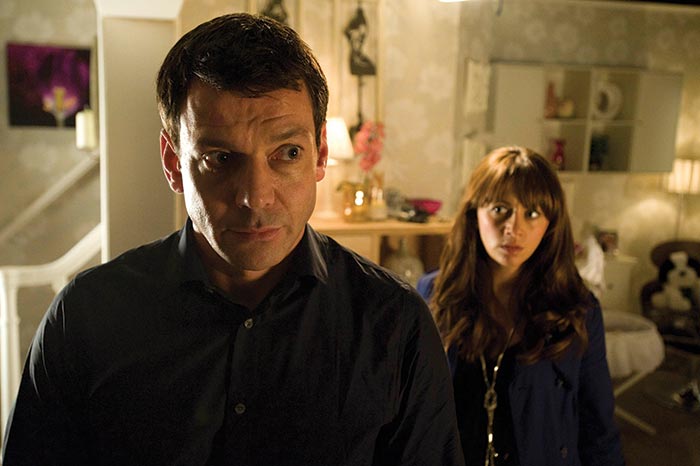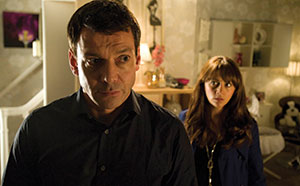
The light is dim in this crowded Toronto diner, the voices loud and steady. A bartender fiddles with the bass on the stereo while six of us, our ages spanning five decades, cozy up in the corner booth and play with the condensation on our glasses of gin and Creemore and cranberry ginger ale. We have come to discuss Coronation Street—its stellar writing, its dry humour, its brisk pacing and relatable cast. But the conversation keeps turning back to Tony Gordon.
As Corrie’s current baddy, Tony in many ways serves as a tidy distillation of the scope of the series, which celebrates its fiftieth anniversary this December. He owns the local lingerie factory, Underworld, but he has distinctly working-class roots. While he makes lots of enemies, often by intimidating the elderly, his bed is seldom cold. He marries Carla (in one of the eighty-six weddings performed over the show’s history). He delivers Maria’s baby (one of thirty-seven births). And he orders a hit on Liam (one of 118 deaths), the father of Maria’s baby, who’d had an affair with Carla, even though Carla is the ex-wife of Liam’s brother, Paul (also dead). Then Tony and Maria start dating (despite the fact that she once tried to run him over with her car). And then, finally—only days before our conversation at the restaurant—Tony tells the police what he’s done.
“This doesn’t happen very often,” admits Mary, fifty-four, a Coronation Street fan since 1982. “The meat of the show is the people in their little houses with their little lives. They’ve lost their jobs, or something’s wrong at home. It’s usually not a serial killer. But Tony’s still an interesting character.”
“He’s a mastermind of deception,” says Ben, who first watched the show thirty years ago with his grandmother, when he was just six, and has been a devoted viewer since 2004. “I’m not quite sure how he made Maria forget she suspected him of murdering Liam, but it kept me watching.”
“I was pulling for Tony to get away with it,” says Laura, thirty-two, who has been tuning in for four years.
“He tried to make amends,” explains Mary. “You almost want to believe that he could be redeemed by loving Maria and that baby.”
“Watching him with Maria and her son, I began to feel like he really has changed,” adds Laura, “that there is some kind of struggle there. That he isn’t purely evil.”
“You think you have Tony figured out, and then something happens to challenge that,” says James, forty-five, an intermittent viewer since the 1970s. “He’s also deepened the characters around him.”
“Even Maria is less boring now,” agrees Petra, James’s fifteen-year-old daughter, who has watched the show with her father for the past three years. “She isn’t just the pretty girl anymore. And she’s not just an addition to her husband.”
The conversation carries on into the night, long after the drinks have been drained and the music has been cranked up. The discussion’s intensity, which mirrors those playing out in living rooms and bars across Canada, raises an essential question about Coronation Street. Now the longest-running scripted television program, the series documents the working-class residents of Weatherfield, a town modelled after a Manchester suburb, whose lives unfold in a very specific location, coloured with the cadences of unpolished British speech. It would be difficult to name a show more quintessentially British. So why do 1.3 million Canadians tune in every night?
Coronation Street was nearly called Florizel Street, but a cleaning lady named Agnes at Granada Television contended that “Florizel” sounded like a disinfectant. The show almost didn’t make it to air, but Canadian producer Harry Elton persuaded skeptical network executives to gamble on the blue-collar drama. (Apparently, Elton—who would later return home to host Cross Country Checkup—knew Corrie had tremendous potential after Agnes was transfixed by the pilot.) Within three months of its premiere in late 1960, the show secured first place in the ratings, pulling in a 75 percent audience share. By the middle of the decade, it had reached a high of 21.3 million viewers—just three million fewer than those who tuned in to learn of JFK’s assassination, and a full million more than those who watched Winston Churchill’s funeral.
The show was a proven revenue generator, and for executives at CBC it must have been easy to imagine that it would find a similarly receptive audience here. When Coronation Street debuted on Toronto’s CBLT in July 1966, English-speaking Canada operated within a distinctly Anglo tradition: we still sang “God Save the Queen,” we had just a year earlier retired the Union Jack, and our Constitution could only be changed by an act of British parliament.
“In the ’60s, when Corrie earned its popularity and became part of people’s daily lives, we were a nation of British expats,” acknowledges Kirstine Stewart, general manager of CBC Television. Stewart’s parents had emigrated from England, and the show was a Sunday fixture in her childhood home. “It was a way for my parents to communicate with their home country, to keep a connection there that was pretty current. So my mom would prepare the Sunday roast, and then I would hear the tones of naaaaaa na na na-na-na”—she takes a stab at the iconic theme song—“and I would know Corrie was coming up.”
In September 1981, Coronation Street went national in Canada, appearing in half-hour instalments on weekday afternoons and again in a Sunday-morning omnibus. Thirteen years later, CBC elected to elevate those weekday episodes to prime time, where periodic pre-emptions for events like the NHL playoffs and elections have resulted in a ten-month lag behind the British broadcasts. In its current prime-time slot, and despite increased competition from specialty channels, the show routinely commands a 10 percent audience share. And its viewership doesn’t merely comprise septuagenarian ladies with teacups in hand: men constitute approximately 40 percent, and Sunday broadcasts attract more Canadians in the thirty-five to forty-nine age group than those over fifty. (The audience is also surprisingly tech savvy—the show was streamed online more than six million times over nine recent months.) Corrie is the network’s most watched narrative program by a mile, and can draw higher numbers than that other CBC flagship, The National.
“It’s a huge boon to us,” says Stewart. “It does very well with advertising, and it’s money that goes back into making homegrown Canadian shows. So that’s the benefit of having it on prime time. And using our foreign allotment to put on this UK program, as opposed to American programming, is somehow more palatable in terms of the whole public broadcasting structure.”
But Stewart is quick to point out that Coronation Street’s continued relationship with CBC can’t be chalked up to just profits and politics: “We want to bring the best of the world to Canadians, and Corrie is a legacy piece. It’s not just something you look back on with nostalgia; it reinvents itself. It reinvigorates. And Coronation Street fans are the most loyal, except maybe for curling viewers, of all CBC viewers.”
On December 9, the series’ fiftieth anniversary, the network will air a one-hour tribute to those fans called Corrie Crazy, hosted by Newcastle native and Corrie devotee Debbie Travis. “We wanted to have a birthday party for the show,” says Stewart. “It’s been a great long-term association, as we head into our seventy-fifth anniversary and they celebrate their fiftieth. It just goes to show that the old birds can still kick some butt.”
No television program could enjoy such popularity for such a long time without addressing some fundamental aspect of our cultural consciousness. As we loosened the colonial ties that were so prominent in the 1960s, when Coronation Street was first beamed into our living rooms, Canada transitioned from being a nation largely defined by British affiliation to one shaped through opposition to America. This came with some growing pains: an acute anxiety that, compared to our southern neighbour, we didn’t measure up.
In his 1973 essay “Coward, Bully, or Clown,” academic Robert Fothergill characterized this anxiety as classic younger brother syndrome. Older brother America, more enterprising, more visible, “has quite naturally grown up with an aggressive self-assurance,” while younger sibling Canada took his sweet time moving out of the house. “An abiding sense of himself as inescapably diminished, secondary, immature,” Fothergill writes, “has become second nature, has indeed shaped his nature and bred into it a self-thwarting knowledge of personal inadequacy.” Plagued by such feelings of incompetence, Canadians unsurprisingly make and gravitate toward art that champions what we might call, to borrow from Leonard Cohen, the beautiful loser.
Fothergill’s essay explores that tradition in Canadian cinema, but his arguments can be extended to the most successful television programs our country has produced. If American shows were going to be highly commercial, glossy affairs, ours would celebrate the conspicuous absence of glitz and glamour. The Beachcombers, King of Kensington, The Red Green Show, Trailer Park Boys, SCTV’s “Great White North,” Corner Gas—each brims with lovable schlubs. And Coronation Street—with its cast of working-class, ordinary-looking characters hunched over the local bar in hand-me-down clothes—boasts the schlubbiest of them all.
Viewers respond to the importance Corrie places on social realism, says Sarah Matheson, an associate professor at Brock University in St. Catharines, Ontario, who specializes in television studies. “Even though Weatherfield is a fictional place, the characters are situated in a clearly drawn social and cultural milieu, and this environment is shown to be crucially important to their circumstances and the struggles they face.” Their issues have universal appeal, allowing Coronation Street to reach across borders and demographics. Committing to a grittier style, the local dialect, and the modest spaces of the factory, the pub, and the home, Matheson says, “allows the show to establish a sense of authenticity.”
“We now have this expectation,” argues Rebecca Sullivan, an associate professor in the Department of English at the University of Calgary, that “the lower-budget and more true to life something looks, the more Canadian it is.” She traces the roots of that belief to the Massey Report, which challenged Canadians to resist America’s cultural invasion and cultivate our own arts tradition. Coronation Street’s inclusion in Canadian television, and the prominence it has since garnered on CBC’s schedule, speaks to the network’s role in our culture.
“Since the Massey Commission,” explains Sullivan, “CBC has said, ‘This is what we’re going to do. We’re going to be middlebrow. We want our television to be edifying. We’re not going to be lost in socially irresponsible fantasy. So while Corrie is as British as British can be, and its meanings and values in the UK are quite different, it nonetheless has a very specific role to play in the Canadian zeitgeist. It fits almost perfectly with what Canadian narrative television should be—except for the fact that it’s not Canadian.”
It is fair to suggest that Canadians continue to watch Corrie in such impressive numbers because the show simultaneously speaks to an entrenched anglophilia, to our working-class roots in the Empire, to a national inferiority complex and a desire to distinguish ourselves aesthetically from America’s cultural imports. These ideas must surely provide a partial explanation—but they’re not the reasons Corrie viewers give. They say they watch because the show is so bloody good.
And in addition to watching, they exhibit an insatiable appetite for discussing and analyzing it, a habit that’s been exponentially enhanced by the Internet. In early 2005, looking for a forum for her thoughts about the series, Toronto technical writer Jacqueline Myers launched Corrie Canuck, a blog offering episode updates and tributes from a Canadian perspective. “Within a month, all these very clever, very funny people were commenting,” she says. “I couldn’t really keep up with it myself, so other people started to help.” The website now has a roster of eight contributors, and the community remains active; in the past three years, Corrie Canuck has received nearly 850,000 page views and some 18,000 comments on the posts.
“Coronation Street tackles very nuanced characters and a diversity of issues, and I think that’s attractive to Canadians,” says Myers. “Sure, there are affairs and murders—that street must have the highest homicide rate in the world—but they’ve touched on everything from transsexuality to Asperger’s. And it isn’t sensationalized. It isn’t bigger than life.”
“They’ve had a number of accepted, high-profile gay characters; it was a leading show in that regard,” says Tom Dreyer, an orthotics manufacturer from Thunder Bay, Ontario, who contributes to the website. “And there have been some fabulous storylines that explore some pretty serious stuff. A woman who kills her abuser—is that murder, or is that self-defence? Coronation Street isn’t afraid to ask questions of people or society.”
For Montreal’s John Hansen, a pricing analyst for Air Canada and one of the earliest contributors to Corrie Canuck, the appeal lies in the rich, expansive community Corrie has created and how superbly crafted the series remains. “The show has a fifty-year history; that street is really its own universe,” he says. “The script employs an awful lot of irony, and sneaks in very clever dialogue. It’s one of the best-written shows on TV.”
On this, the writing skill, Corrie enthusiasts are in total agreement. “The dialogue is so snappy,” says one fan. “The writers manage to blend drama and comedy perfectly,” says another. A third fan admits that she was, at first, a reluctant viewer—“I mean, it’s old British people, and it’s a soap opera, and it’s on CBC”—but credits the strength of the writing for winning her over.
Dedicated fans who wake up early to watch the Sunday omnibus or dissect last night’s big reveal in a blog post don’t place Coronation Street within the traditions of low-budget aesthetics and beautiful losers—at least not in a deliberate way. Instead, they see the show as a descendant of the very best of literary fiction. The rash violence, the attempts at justification, the slow journey to atonement—Corrie is cribbing from Crime and Punishment. The characters bordering on caricature, who remain somehow grounded by the finely drawn details of their workaday lives—that’s directly from Dickens. (Beloved restaurateur Roy Cropper’s name wouldn’t be out of place in Bleak House.) “Even when the characters are broadly drawn, every episode will have a line or a moment that reminds you there’s another layer to them underneath,” says a long-time viewer who is struck by a prominent Dickens influence in the show.
In 1841, scores of New Yorkers swarmed the pier to receive their last instalment of The Old Curiosity Shop. As the British ship docked, the waiting crowd shouted to the incoming passengers, “Is Little Nell dead? ” Canadians demonstrate a similar hunger as they take their places on couches across the country for an evening’s episode of Coronation Street. It’s the relationships they’ve built with the characters that draw them there; it’s the themes that resonate with their lives. It’s good storytelling—and it travels.
This appeared in the January/February 2011 issue.




